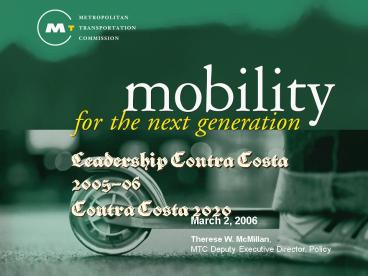Leadership Contra Costa 200506 - PowerPoint PPT Presentation
1 / 15
Title:
Leadership Contra Costa 200506
Description:
Bay Area drivers made an estimated 21 million trips. Length of average trip increased 25.6 ... 42 to ensure gasoline tax revenues are directed to transportation ... – PowerPoint PPT presentation
Number of Views:35
Avg rating:3.0/5.0
Title: Leadership Contra Costa 200506
1
- Leadership Contra Costa 2005-06
- Contra Costa 2020
- March 2, 2006
- Therese W. McMillan, MTC Deputy Executive
Director, Policy
2
Traffic Congestion Persists
- Bay Area drivers made an estimated 21 million
trips - Length of average trip increased 25.6 minutes in
1990 to 29.4 minutes in 2000 - Recent dip in traffic congestion is
recession-related
3
Commuters Crisscross Region
- Top 3 corridors with increase in daily trips
- 116 increase in daily trips over I-680/Sunol
Grade between Alameda and Santa Clara counties - 90 increase on I-580 corridor between Alameda
and Central Valley counties - 68 increase on Routes 12 29 from Napa and
Solano counties
4
Making the Down PaymentProjected 25-Year
Revenues for Financially Constrained Element
- 118 billion spending plan is primarily focused
on maintaining and operating the existing
transportation system
5
More Potholes Ahead
- 16.7 billion in roadway maintenance costs
- 10.6 billion in revenues available as down
payment - Results in 6.1 billion shortfall
- Strengthen Prop. 42
- Strengthen Prop. 42 to ensure gasoline tax
revenues are directed to transportation - The Problem is Bigger than Prop. 42 Alone.
- Years of neglect have left our transportation
system in a state of disrepair.
6
Keep Trains and Buses Humming
- 16.7 billion in transit capital costs
- 13.4 billion in revenues available as down
payment - Results in 2.8 billion shortfall
- Strengthen Prop. 42
- Strengthen Prop. 42 to ensure gasoline tax
revenues are directed to transportation - Promote efficiency
- Consider institutional and functional transit
consolidation measures that improve efficiency
7
State Highways Showing Their Age
- 14 billion in State highway maintenance costs
- 7 billion in revenues available as down payment
- Results in 7 billion shortfall
- MTC Supports more SHOPP Funding
- Delays in maintenance will increase cost of
roadway repairs - However, directing more funding to SHOPP
addresses repair needs, but leaves less State
funding for expansion projects - SB 1024 would bring money into the STIP and repay
past loans
8
Squeezing Better Mileage from Existing Network
- Use Technology to Improve the Commute
- Install and operate traffic monitoring systems,
ramp metering and traffic signal timing to
improve traffic flow - Implement real-time communications systems to
clear incidents quickly - Provide commuters travel-time reliability to make
their lives better
- 742 million needed to deploy Regional Operations
Program - 329 million in revenues available as down
payment - Results in 413 million shortfall
9
HOT Network Delivers Carpool Lanes and
Congestion Insurance
- HOV lanes shave 15-20 minutes off peak commutes,
offering commuters a way to beat congestion - Express buses use HOV lanes to bypass traffic and
provide faster, more reliable service - HOT lanes introduce pricing element into highway
use by giving solo drivers option to pay to
bypass congestion
- Regional HOT Lane Network
- I-680 Smart Carpool Lane implementation set for
2009 start-up - MTC and Caltrans to lead Regional HOT Lane
Analysis beginning of 2006
10
Moving Goods to Market
- I-880 Corridor Improvements
- Deploy ITS and operational strategies
- I-580 Corridor Improvements
- Truck climbing lanes inland rail/barges truck
toll lanes - I-80 Corridor Improvements
- I-80/680 interchange
- US 101 Peninsula
- Operational improvements
- Southern Gateway
- SR 152/156 improvements
- Over 37 percent of Bay Area economic output is
manufacturing, freight transportation, and
warehouse and distribution businesses - 80 percent of freight movement occurs on freeway
corridors, especially I-880, U.S. 101 and I-80
corridors, followed by rail and air cargo - Port of Oakland facilitates maritime freight
movement, but is increasingly constrained due to
congestion problems
11
Resolution 3434 Bay Areas Vision for Transit
Expansion
- MTC Resolution 3434 identifies nine new rail
extensions, express buses, ferry service, and
enhancements to existing rail and bus corridors - Success of these transit investments depends on
many factors, including supportive land uses
- Transit Expansion Needed to Meet Regional
Population and Job Growth Projections - MTC adopted TOD policy in July 2005
- MTC also committed 2.5 million to support
partners in station area planning efforts
12
Enhancing Livability by Connecting Transportation
And Land Use
- Nearly 2 million people and 1.4 million jobs to
be added to Bay Area - Partnerships amongst regional and local agencies
needed to facilitate integration of
transportation and land use - Joint Policy Committee formed to
coordinateregional planning efforts and pursue
implementation of the Smart Growth Vision,
which was adopted in 2002
- Provide More Land-Use Planning Funds to Partners
- MTC provides local planning funds through T-PLUS
- The key to effective transportation is adequate
housing in the right places.
13
Revenues Cant Keep Pace With Demand
- Increases in transit ridership and traffic
congestion will put significant strains on
traditional funding stream - In real terms, revenue from fuel taxes is
inadequate even to maintain the existing system - Equivalent impact with federal gas tax
14
Local Revenues Help Tremendously
- There are a number of voter initiatives and fee
structures that can be applied to the funding
shortfall - One of the most promising new revenue sources is
the use of high occupancy toll lanes that offer
both congestion insurance and new financing
opportunities for major projects
Approved by voters in November 2004
Requires further action
15
- Leadership Contra Costa 05-06
- Contra Costa 2020
- Copies of this presentation can be downloaded
from MTCs website at http//www.mtc.ca.gov































